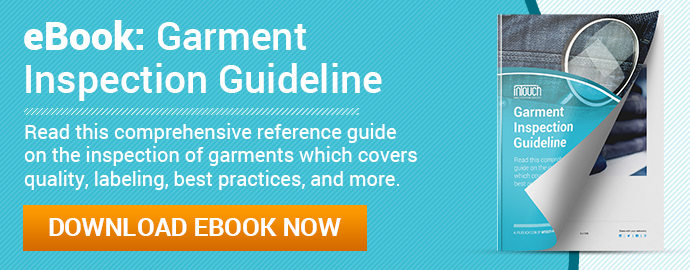 As a garment importer touring your supplier’s factory, you likely have one thing on your mind: the anticipation of customer satisfaction as they buy an item from your product line.
As a garment importer touring your supplier’s factory, you likely have one thing on your mind: the anticipation of customer satisfaction as they buy an item from your product line.
But there’s a problem.
The “quality” fabric from your supplier doesn’t meet your standards. In fact, it has a lot of problems. Fabric inspection reveals countless defects ranging from drop stitches to color shading variation.
The scale of defects makes it clear the garment manufacturer will have to cut around the issues to use the fabric, wasting material in the process.
Where do these kinds of fabric defects come from? And how can you prevent them from negatively impacting fabric quality (related: How MMI Textiles Improved Fabric Quality to Retain Key Customers [case study])?
The 4-point system is the industry standard for evaluating fabric quality in the inspection industry. This system assigns penalty points to a roll of fabric according to defect size, quality and significance.
But you must understand the different types of fabric defects to look for before you can use the 4-point system. Read on or click the links below to jump to different sections to learn more about each of these fabric defects.
1. Horizontal lines
This fabric defect is defined by irregular lines that run from side to side. 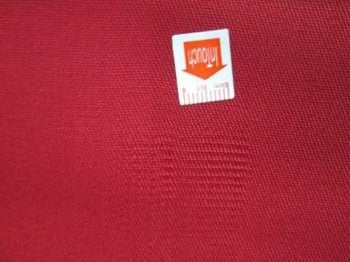 Horizontal lines are generally caused by:
Horizontal lines are generally caused by:
- Faults in the bobbin (the barrel used to hold yarn in place)
- Irregular thread tension
Causes and prevention of horizontal lines
Preventing the appearance of horizontal lines in fabric is quite straightforward. Regularly replace the bobbin and frequently check thread tension and positioning.
2. Shade variation
One of the more obvious visual defects that can be found on raw textiles, shade variation is defined by a difference in depth of shade and color from roll to roll or piece to piece. Shade variation in fabric is caused by:
- Mixing of fabrics used in production
- Variations in the production process with regard to time and speed
- Improper cutting, bundling and/or numbering
- Unequal fabric stretching
Causes and prevention of shade variation
Using the same base material and set of parameters for each production lot can effectively prevent shade variation.
When visiting a factory that manufactures raw textiles, it’s critical to ensure workers are only combining garments of the same color and not taking shortcuts when cutting and bundling. Properly numbering textile types prevents mistakenly combining cuts that vary in shade.
3. Dirt/stains
Stains are fairly common among dyed textiles and are defined as spots or patches of differing color. Textiles are never truly safe from stains because they can occur anytime during or after production if they’re not kept in an area with adequate protection.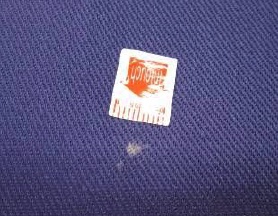
Stains can appear on fabrics from just about any source. Dirt from the factory floor, oil from machinery and dyes are all known sources. Stains are relatively easy to identify and prevent so long as suppliers are vigilant about fabric quality.
Causes and prevention of dirt/stains
Your manufacturer can prevent stains during production by regularly cleaning production machines and equipment to ensure no random oils, grease or dyes make their way onto the textile.
Wrapping the finished rolls of fabric in plastic and storing them in a separate area away from the dying area can help avoid post-production stains.
4. Uneven dyeing/printing/dye marks
Dye marks are irregular patches on the surface of raw textiles. Dye marks are typically the result of: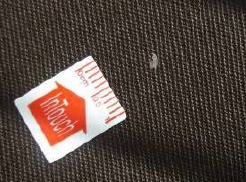
- Low quality base fabric
- Improper leveling agents
- Incorrect pH in the production process
- Dye machine entanglement
Causes and prevention of dyeing/printing/dye marks
Ensuring there are no initial problems with the base fabric prior to stitching can help prevent dye marks. Any issues missed will be present in later production processes.
Other preventative measures include maintaining the correct pH level, using an appropriate dying agent and using a backup power generator to ensure production machines don’t shut down during use.
5. Drop stitches
One of the most common quality issues found in raw textiles, drop stitches are holes or missed stitches that appear randomly in the fabric.  Drop stitches are typically caused by:
Drop stitches are typically caused by:
- Incorrect set-up of yarn carriers
- Slubs and knots
- Yarn overfeeding or underfeeding
- Loose stitching during the production process
Causes and prevention of drop stitching
Checking the yarn carrier and any other machines to verify they’re set to the right tension during production can prevent drop stitches. You can minimize the occurrence of drop stitching in your fabric or textile by regulating the yarn feed rate.
Resetting the pattern chain can fix this issue.
6. Misprinting, off printing or absence of printing
Misprint defects are only relevant to printed fabrics. Misprint is when the print of the fabric does not match your specified design. This is usually displayed in one of the following ways:
- Colors and/or patterns are completely or partially missing
- Colors and patterns are incorrectly positioned relative to each other
Causes and prevention of misprinting
Misprints are most often the result of:
- Wrong dyeing recipe
- Wrong leveling agent
- Incorrect dye combinations in lots
- Improper scouring of grey fabric
Implementing uniform dyeing, leveling and scouring processes can help prevent misprinting.
If you’re sourcing a printed fabric, make sure to provide clear specifications regarding the colors and patterns of your printed fabric to your factory. Consider providing pantone color numbers and design files as a guide for your supplier.
7. Crease marks
A crease mark is a visible deformation in fabric. A crease mark differs from a crease streak, as it’s unlikely to appear for an entire roll. Rather, it appears in just one spot on the fabric.
 If final pressing cannot restore fabric to the original condition, a crease mark will be left on the final product. Discoloration can also be a problem associated with this fabric defect.
If final pressing cannot restore fabric to the original condition, a crease mark will be left on the final product. Discoloration can also be a problem associated with this fabric defect.
Causes and prevention of crease mark
Crease marks often happen when fabric passes through squeeze rollers in the dyeing process. Creasing is inevitable as fabric is fed through machines in rope form. But if properly handled, crease marks should not be permanent.
Crease marks can be caused by:
- Inadequate preparation, relaxation or bulking of fabric
- Poor quality of fabric: a tight construction, high twist yarns or dense weight
- Poor suitability of machine: not moving folds properly
- Incorrect loading of fabric into machine, resulting in twisted or knotted rope
- Excessively rapid heating or cooling rates
Along with rectifying these issues, using anti-crease agents during the scouring process prior to dyeing can help prevent crease marks.
8. Barre
A barre is an unintentional, repetitive visual pattern of continuous bars and stripes.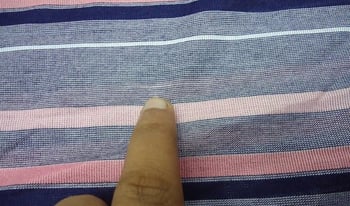
Barre will typically appear as a horizontal streak of light or dark bars running the width of the fabric. The bars must appear in a repetitive pattern to be considered barre. Barre is typically found parallel to the filling of woven fabric or to the courses of circular knit fabric.
Barre is usually not detected until after the processing of fabric at the end of production.
Causes and prevention of barre
Barre is a result of physical, optical or dye differences in yarns or geometric differences in fabric structure. Any combination of these differences can cause this fabric defect.
Like many fabric defects, it’s easier to prevent barre than to try and rectify it after production. Consistency in raw material organization and labeling can help prevent mix-ups leading to barre, as well as continual equipment maintenance. Following a First In First Out (FIFO) inventory system can help ensure consistent material flow and usage.
9. Neps/knots
Neps are small, tightly tangled knot-like masses of unorganized fibers that form a pinhead shape. These knots are usually comprised of dead or immature fibers.
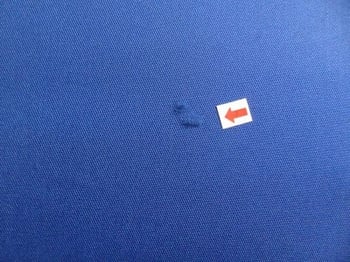 Neps can be categorized into three types:
Neps can be categorized into three types:
- Biological: Found in raw materials, these neps contain foreign material such as seed coat fragments, leaf or stem materials. The manufacturer can usually remove them through wet processing.
- Mechanical: Found in ginned lint, card web, yams and cloth, these neps are largely a result of mechanical processing.
- White speck neps: Generally not visible until dyeing, white speck neps contain immature clusters of fibers and are considered the most severe type of neps.
Causes and prevention of neps
Neps are caused when spools of yarn are tied together. This might be a result of:
- Accumulation of fly and fluff on machinery
- Poor lint cleaning
- Poor carding and incomplete removal of neps before processing
To prevent neps and knots, ensure proper maintenance and cleaning of machinery and roller clearers. Neps can be removed through combing before processing, so early detection of neps is critical to preventing neps in finished fabrics.
10. Abrasion marks
An abrasion mark is a discolored area damaged by friction or rubbing.  Abrasion marks are sometimes also referred to as chafe marks or bruised places.
Abrasion marks are sometimes also referred to as chafe marks or bruised places.
Causes and prevention of abrasion marks
Chafing or impact with a hard or rough surface usually causes abrasion marks. For instance, scratches on the breast beam of the loom might cause chafing.
Abrasion resistance is the ability of a fabric to withstand surface wear and rubbing. Fiber, yarn and fabric properties and finishing processes are the main factors that determine abrasion resistance.
Using fabrics that are more abrasion resistant can help reduce abrasion marks. Nylon is generally regarded as having the best abrasion resistance, followed by polyester.
11. Splicing
Splicing is the overlapping of the cut ends of two pieces of fabric (the end of one length of fabric and the beginning of another) to ensure continuous spreading. Splicing is necessary as one roll of fabric finishes and the next is taken into use.
 But these overlapping ends of fabric produce a waste material in manufacturing. Splicing losses can vary up to five percent of total fabric usage. Importers can ensure greater manufacturing efficiency by minimizing splicing in their fabric.
But these overlapping ends of fabric produce a waste material in manufacturing. Splicing losses can vary up to five percent of total fabric usage. Importers can ensure greater manufacturing efficiency by minimizing splicing in their fabric.
Many importers assign four penalty points under the 4-point system for each splice found during fabric inspection.
Causes and prevention of splicing
The position of the splice in a roll of fabric often depends on the overall fabric quality. Splicing is often used to compensate for other fabric defects, like stains or holes, by removing these from the final roll.
So improving overall fabric quality and preventing other fabric defects can often help to minimize splicing losses.
Setting a maximum length tolerance for splicing in each roll of fabric with your supplier can help to clarify your expectations (e.g. no more than one splice every 30 meters). Be sure to consult your supplier on this tolerance before production to ensure it is achievable.
12. Holes
A hole is an imperfection where one or more yarns are sufficiently damaged to create an opening in the fabric.
 Holes are typically treated as a major defect in the fabric and are assigned either two or four penalty points during fabric inspection, depending on their size.
Holes are typically treated as a major defect in the fabric and are assigned either two or four penalty points during fabric inspection, depending on their size.
Causes and prevention of hole
Holes are usually caused by an accidental cut or tear to the fabric. Broken needles or rough mechanical parts are common culprits for fabric tearing during manufacturing.
Prevent future holes by ensuring your supplier has procedures in place to regularly check needles and machinery prior to production.
13. Defective selvage (cut, waved or creased)
Selvage is the densely woven edge of a piece of fabric. Most often used in reference to woven fabrics, the selvage is supposed to keep the fabric from unraveling or fraying.
 Selvage can be defective in a number of ways, including cut, waved or creased. Cut selvage might also be referred to as broken selvage or ripped selvage.
Selvage can be defective in a number of ways, including cut, waved or creased. Cut selvage might also be referred to as broken selvage or ripped selvage.
Causes and prevention of defective selvage
There are two main culprits for defective selvage:
- An incorrect loom adjustment during weaving
- Improper edge construction
Correctly adjusting the loom and properly constructing the edges of the fabric should prevent this defect.
14. Snags
A snag is a part of the yarn that is accidentally pulled or plucked from the surface. Usually it appears as a large loop of yarn above the surface of the fabric.
In warp knits, the snag occurs in the wale direction. In weft knits, the snag occurs in the course direction.
Causes and prevention of snag
In the case of continuous filament yarns, snagging is typically caused by mechanical strain during knitting. Sharp points and objects can cause the fabric snag at any time. Inspect the fabric contact points on all the processing machines to identify and fix any sharp points.
Some fabrics are more prone to snagging than others due to their composition. You can conduct a mace snag test to determine a fabric’s resistance to snagging. During this test, a miniature mace (a spiked ball) will track randomly across a fabric sample to predict actual wear and snagging.
15. Thick place/thin place
These are unintentional changes in fabric appearance as compared to adjacent construction. 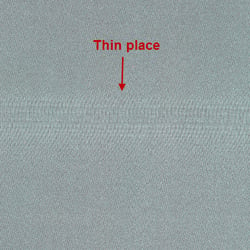 If the thick or thin place is more than one inch wide, it is typically classified as a major defect in fabric inspection.
If the thick or thin place is more than one inch wide, it is typically classified as a major defect in fabric inspection.
A thick place will appear as a small area of more closely spaced yarns or by a congregation of thick yarns. A thin place is the opposite, as the fabric will appear to have loosely spaced yarns or a congregation of thin yarns.
Causes and prevention of thick place/thin place
Main causes of thick and thin places include:
- Irregular let-off
 Incorrect setting of holding and releasing pawls on the ratchet wheel of take-up motion
Incorrect setting of holding and releasing pawls on the ratchet wheel of take-up motion- Gears of take-up motion not meshing properly
- Gear wheel teeth worn out or broken
Ensuring proper training of factory personnel to set the let-off and/or take-up motion properly can help prevent this fabric defect.
16. Bowing and skewing
Bowing is a condition in woven textiles where filling yarns are displaced from a line perpendicular to the selvages and lie in an arc across the width of the fabric. Bowing appears as rows of courses or yarn-dyed stripes forming a bow shaped curvature along the fabric width.
 Skewing is a similar condition in which filling yarns are angularly displaced from a line perpendicular to the edge or side of the fabric.
Skewing is a similar condition in which filling yarns are angularly displaced from a line perpendicular to the edge or side of the fabric.
Bowing and skewing affects striped or patterned fabric quality more than for solid color fabrics, as the greater contrast in patterns makes the distortion more prominent.
Causes and prevention of bowing and skewing
Bowing and skewing can be caused by an uneven distribution of tension across the fabric width during dyeing or finishing processes. Improper stretching during scouring, dyeing or finishing might also cause bowing or skewing.
Correcting the tension settings on processing machines should rectify these defects. You can also ask your supplier to fix bowing and skewing found during fabric inspection by reprocessing the fabric through a compactor or straightening machine.
17. Needle lines
Needle lines appear in weft knit fabrics, and appear as prominent vertical streaks or lines in the fabric.
Causes and prevention of needle lines
Defective needles are a direct cause for needle lines. Needle latches, hooks or stems might be:
- Mixed
- New
- Dirty or contaminated with lint
- Bent
- Worn
If needle lines occur individually, you’ll likely only need to trace the needle line to the associated defective needle and replace it to prevent further needle lines. If needle lines appear in a band, you’ll likely need to replace multiple defective needles.
An improper dial or cylinder condition with the machine might also cause needle lines. Verify that your supplier has established and maintained proper maintenance and cleaning policies to prevent future issues with needles and equipment.
18. Coarse pick
A coarse pick is where the filling yarn used in the fabric is unusually large in diameter. This defect is also known as coarse filling or thick filling.
This defect is also known as coarse filling or thick filling.
Coarse pick is usually classified as a major defect during fabric inspection.
Causes and prevention of coarse pick
Probable causes for coarse pick include:
- Lashing of broken end with adjoining end at roving frame
- Disturbed weight of back-top rollers at roving frame and ring frame cause the material to slip under the back-top roller and crease a coarse yarn
19. Coarse end
Coarse end appears in fabric with warp yarn.
Also known as heavy end, this is when the warp end is larger than normal in diameter, even sometimes double in size. The opposite is a fine end, when the warp end is smaller in diameter than normal.
The diameter of the yarn is too large, irregular or contains foreign material, which inhibits a smooth, even fabric.
Causes and prevention of coarse end
Coarse end is caused when two bobbins of roving (wool that has been run through a mill on a carding machine) are running together during spinning. The process of running two bobbins together during spinning is commonly referred to as doubling and is used to remove variations in thickness.
To prevent coarse ends, ensure there are no knots, irregularities or foreign materials in the roving prior to doubling.
20. Broken pick
This defect appears as a broken filling yarn in the fabric weaving. It appears as a sharp discontinuity in the weave pattern over the pick length.
Causes and prevention of broken pick
A broken pick is the result of a break or cut in filling yarn, which results in the insertion of a partial pick in the fabric. This can happen after weft break, weft exhaustion or a faulty weft fork mechanism. Correcting weft stop motion will ensure broken picks are detected before they’re inserted into the fabric.
Ensuring weaving personnel are trained to identify and replace a broken pick during production can also help prevent the appearance of this defect in the finished goods.
21. Broken end
A broken end appears as a broken, untied warp end of a fabric. The yarn is usually broken during weaving or finishing. Broken ends appear as equidistant horizontal lines along the fabric width.
The yarn is usually broken during weaving or finishing. Broken ends appear as equidistant horizontal lines along the fabric width.
Causes and prevention of broken end
This defect is caused by yarn breakage. When the yarn breaks during weaving or finishing and is then woven into fabric the result is a broken end.
Some possible causes for broken ends include:
- Poor preparation
- Weak or irregular yarn
- Excessive warp tension
22. Missing end/end out
This defect will appear in fabric as a fine warp-way crack until the weaver rectifies it.
 A missing end typically appears at the selvage of the fabric. Missing end is also known as “end out” and is typically classified as a major defect during fabric inspection.
A missing end typically appears at the selvage of the fabric. Missing end is also known as “end out” and is typically classified as a major defect during fabric inspection.
Causes and prevention of missing end
A missing end occurs when an extra piece of filling yarn is jerked into the fabric by the shuttle. This happens when a warp yarn is broken or missing during weaving.
Your fabric may end up with missing ends if a weaver improperly draws broken ends in place or the warp stop motion isn’t properly functioning. Weaving should stop immediately when a yarn breaks to prevent introducing missing ends into the fabric.
23. Filling bar
A filling bar, also known as a weft bar, is a visual band or bar across the full width of fabric.  The area will contain less than the normal number of picks, appearing different from the rest of the fabric.
The area will contain less than the normal number of picks, appearing different from the rest of the fabric.
Causes and prevention of filling bar
There are three main causes of a filling bar:
- Defective spinning processes that lead to a variation in the count of weft yarn
- Mixing of different counts or different twist yarns
- Faulty take up motion on the looms
Ensure your supplier has proper controls and organizational processes to eliminate mix-ups and segregate yarn to prevent this fabric defect. In addition, ensure proper operation of spinning and loom machinery to eliminate mechanical causes.
Conclusion
Whether you’re using fabric to produce inexpensive, promotional t-shirts or high-end furniture upholstery, a clear understanding of the various types of fabric defects will help you prevent them. Learning how to identify various fabric defects and their causes can help you ensure fabric quality meets your standards.
Prior to production, consider setting a defect tolerance for fabric quality issues in a QC checklist. Establishing a mutually agreed upon system for identifying and classifying fabric defects can limit potential disputes with your supplier down the line.
If you’re tired of dealing with quality complaints and product returns, consider relying on a third-party inspection company for fabric inspection. Investing the time and effort to rectify issues and prevent future fabric defects will ensure your product meets company and customer standards.
Editor’s note: This post was originally published in April 2016 and has been updated for freshness, accuracy, and comprehensiveness.
Learn how third-party inspection helped one fabric importer reduce quality defects and improve fabric quality in our case study below!
